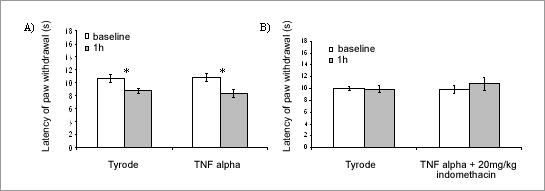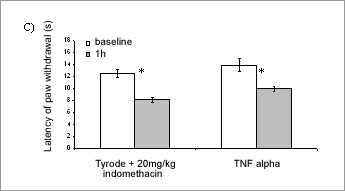Role of prostaglandins in TNFα-induced thermal hyperalgesia Thermal hyperalgesia is the heightened sensitivity to heat and occurs during inflammation. This group has found that bilateral thermal hyperalgesia in TNF α-induced inflammation is TRPV1-dependent (Russell et al., 2005), but the exact mechanisms involved are unknown. TNF α leads to an increase in PGE2 in neurons (Brenneis et al., 2006), therefore the aim of this study was to determine whether TNF α-induced bilateral hyperalgesia is dependent on prostaglandin (PG) production. Female CD1 mice (25-30g) were given intraplantar injections (i.pl.) of TNF α (10pmol/50μl) and Tyrode (as vehicle, contralateral paw; 50μl). Thermal hyperalgesic thresholds were measured using the Hargreaves technique before and 1h after injection (modified as Keeble et al., 2005). Mean of triplicate values was taken as paw withdrawal latency. Indomethacin was co-injected with TNF α i.pl. (10pmol TNF α plus indomethacin (20mg/kg) in total volume 50 mμl) whilst contralateral paw was injected with Tyrode and corresponding amounts of indomethacin vehicle (5% NaHCO3). Another group of mice were injected with TNF α i.pl. plus 5% NaHCO3 with the contralateral paw injected with Tyrode plus indomethacin (20mg/kg). Results are expressed as mean of group ± s.e.m and statistical analysis performed using Student’s t-test. PGE2 metabolite levels were measured using immunoassay (Cayman Chemicals) in sciatic nerves from mice given i.pl. TNF α and Tyrode (contralateral paw). TNF α (10pmol) has previously been seen to lead to reduced paw withdrawal latency in both paws 1h after injection (Figure 1A.). However, local injection of indomethacin (20mg/kg) with TNF α inhibited the bilateral hyperalgesia (Figure 1B.) suggesting that PGs are important in the development of hyperalgesia. Interestingly, indomethacin (20mg/kg) co-injected with Tyrode in the contralateral paw did not prevent TNF α -induced bilateral hyperalgesia (Figure 1C.) confirming that this dose of indomethacin only has a local effect and suggesting that local PG production induced by TNF α is sufficient to lead to bilateral hyperalgesia.
Figure 1. Thermal hyperalgesic thresholds before and 1h post-injection of A) TNF α (10pmol/50μl, ipsilateral paw) and Tyrode (50μl, contralateral paw), B) TNF α with indomethacin (20mg/kg, ipsilateral paw) and Tyrode (contralateral paw) and C) TNF α (ipsilateral paw) and Tyrode with indomethacin (20mg/kg, contralateral paw), n=6-12
Brenneis, C. et al. (2006). FASEB J, 20, 1352-60 F.R. is funded by a BBSRC/Pfizer Case Studentship. |
|



